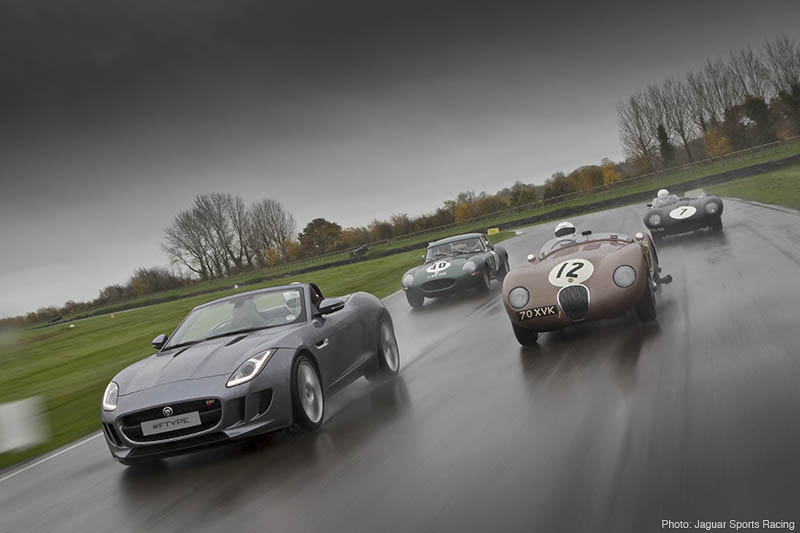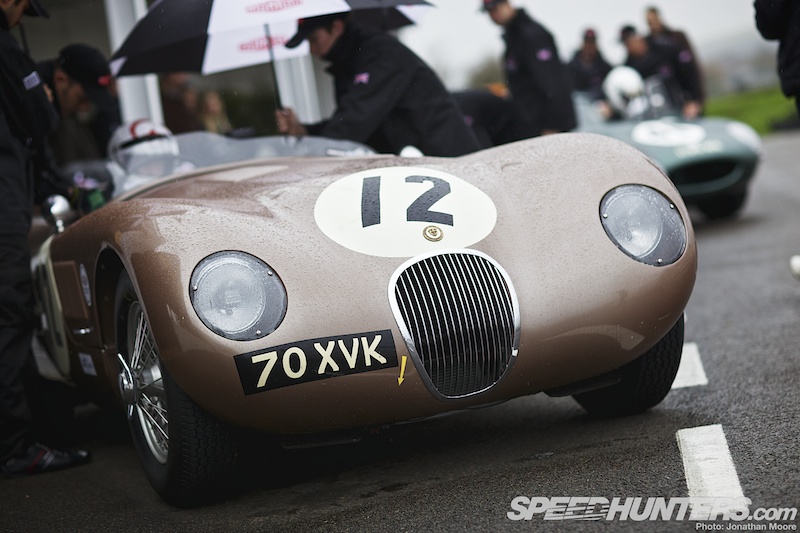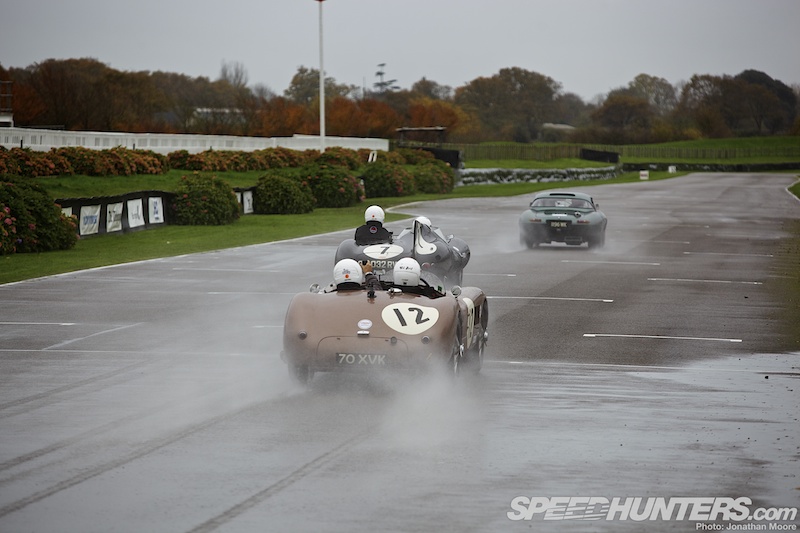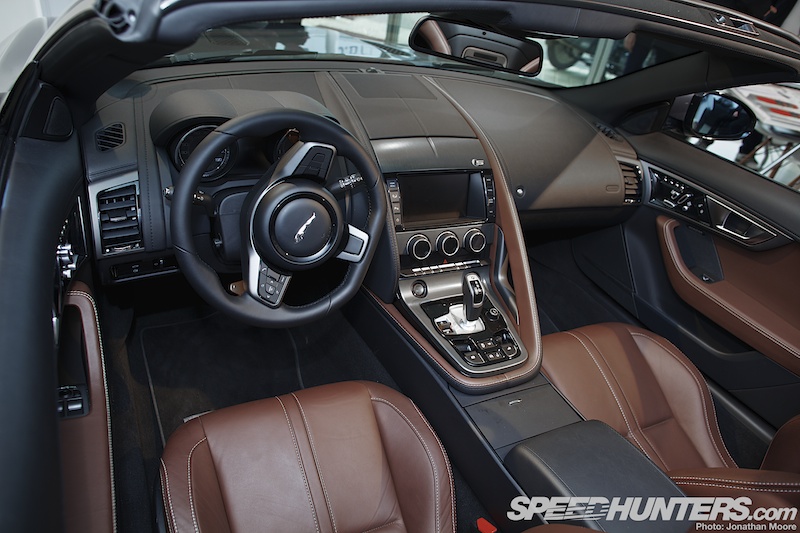
The launch of the new Jaguar F-Type has meant the reintroduction of the classic Jaguar sportscar letter-based naming convention after an almost 50 year break. C- and D-Type Jaguars conquered the 24 Hours of Le Mans five times in seven years during the ’50s; E-Types won their class at Le Mans in the ’60s and raced in multiple series all around the world. Now Jaguar’s F-Type roadster is looking to reignite a sporting bloodline stretching back over 75 years.

It’s potentially a risky thing to do from a marketing perspective, and something the firm has seemingly avoided for quite a long period of time. The historic weight that is automatically assigned to the new car means that Jaguar must be absolutely convinced that the F-Type is the right name for the right car at the right time. But this is a deliberate and sensible plan, and the company are reviving their racing involvements as the centrepiece in their objective to return attention to their performance heritage.

At the heart of Jaguar’s campaign is the Jaguar Heritage Racing programme: an impressive collection of racers from the marque’s past that includes some classic examples of race-winning chassis, taken out not just for show but run in anger in historic racing series around Europe.

So what better way to celebrate the birth of the F-Type than by showing it off in the company of its older sisters. And then what better place to hold the event than at the Goodwood track in West Sussex, home to so many Jaguar successes in both the classic and modern era.

A brand new F-Type joined a C-Type with a particularly interesting history, a Le Mans-winning D-Type and a very successful E-Type at a soaking Goodwood for the very special day – with the highlight being the opportunity to ride shotgun in each car on hot laps around the track.

Expert restoration firm JD Classics manage the collection on behalf of Jaguar, meaning the cars couldn’t be in better hands.

The day dawned cold and damp – and got worse from there. It meant that not only would the old Jaguars be more nervous out on track than normal, but potentially the drivers as well given the value of the three cars…

It’s not every day you get to sample a classic racing car from the cockpit, which in itself is always a privilege. But to be able to experience three iconic racers back to back, on the same track and on the same day, was an electrifying prospect.

We’d be taken out in the C-Type by Wil Arif: he’d cut his teeth driving in Thundersports, single-seaters and saloons in the ’80s, and is a well-known driving instructor at race tracks around the UK.

The D-Type would be driven by JD Classics’ boss Derek Hood, an experienced historics racer in his own right.

The E-Type would be pedalled by current British GT driver Alex Buncombe, whose usual mount is the big Nissan GT-R GT3 car. However, he’s more than familiar with the older machinery, and has been racing this E in various series during 2012 – winning seven out of eight races entered.

Also on hand was legendary Jaguar development engineer and works driver Norman Dewis, a sprightly 90 years young. Norman helped develop all of the Jaguar racing cars represented here, and drove with Stirling Moss on the 1952 Mille Miglia during testing of the disk brakes for the C-Type.

With the rain falling with increasing intensity, the session started and the first lucky passengers lined up to be strapped in.

That was the first problem, particularly with the C- and D-Types: these cars may have had rudimentary passenger seats thanks to the enduring sportscars-must-be-two-seaters rule, but that didn’t make the process simple or easy. The problem was trying not to damage the car whilst also not damaging yourself!

The most obvious thing about the racing purpose of the D-Type was just how high up the temporary passenger sat compared to the tucked-down driver’s cockpit. In the second seat it felt like your entire torso was exposed to the airflow, with the helmet taking the full force of the air blowing over the streamlined nose of the Jaguar.

The D-Type, designed by Malcolm Sayer, was a very fast car: good for 190mph down Le Mans’ long straights. With its monocoque body construction and subframes carrying mechanical components it’s the forerunner to all modern racing cars. The aerodynamics were also cutting edge, having been developed in a wind tunnel, with the dorsal fin aiding stability and the fared-in wheels helping keep the car slippery.

Although Derek wasn’t pushing to the limit, the D-Type felt serene around the track despite the weather: smooth and controlled. Seeing the rain drops streaming off the D-Type’s beautiful long British Racing Green nose was a magical sight that is now etched into my memory. This D is the ’55 works Le Mans car, driven by Mike Hawthorn and Ivor Bueb. Following that race it was shipped to the US and became Briggs Cunningham’s race-car.

Back in the pits it was clear that the big team of JD Classics mechanics weren’t here to just keep the rain off. As with any racing car, these Jaguars needed constant attention to keep them running at peak performance, whether it be set-up tweaking or topping up of fluids. Ah, the smell of racing oil!

The C needed some blanking tape to help with keeping the temperatures up in the cold conditions, and every so often the hood was popped for a quick check and a refresh of tape.

Next up, the E-Type. What an utterly legendary machine. An iconic racing car that still stirs the soul of anyone who loves the smell of petrol in the morning. The cockpit was naturally better appointed than the purebred C- and D-Types: a proper racing bucket seat with five-point harness, with the only discomfort provided by the spec fire extinguisher banging against your knees.

So, would it be driven gently, what with the now waterlogged track and value of the car? Not a bit of it. Alex monstered the Jag around Goodwood, absolutely hanging it out from the second the car left the pit-lane.

Goodwood is not an easy track to drive under any circumstances, and most of the run-off areas seem to curve in towards the track rather than away, which is rather disconcerting. Me, I was too busy marvelling at Alex’s inch-perfect car control as he fought the car on the throttle through the corners before mashing the throttle down the straights, countering the ever-changing traction at the rear with constant corrections of the wooden-rimmed wheel and somehow keeping the thing always pointing forwards.

I spent as much time watching Alex’s feet dancing in the pedal box as I did looking out of the window: through St Mary’s the car would be arcing across the wet track as Alex fought for traction through the tightening left; the Lavant hairpin was a blur of opposite lock in a titanic battle of power versus grip; Woodcote a seemingly impossibly fast and late turn-in; and the Paddock chicane a belt-testing quick-change mash from third to second before the power came down well before what should be legal. Simply epic.

This Lightweight has been completely rebuilt by JD Classics to original racing spec and has its complete FIA Historics conformity papers. Everything major has to be exactly as it was in period: you can choose brake pad material and the make of shock for instance, but they all have to conform in size and specification to the original homologation document. Disks have to be solid; the exhaust manifold as per the homologated part; suspension points can’t be moved, limiting camber; the weight limit is set in stone. It’s almost exactly what you would have had delivered to your team in 1963.

Finally it would be the C-Type with Wil in control. What a completely different experience. Skinny tyres and effective but old-fashioned suspension matched with a 325bhp 3.4-litre engine – in these conditions? How tight were these belts going to be?…

It lacked the ferociousness of the E-Type, but had none of the reassurance of the D: it sat squarely in the middle, with every corner looking to challenge what little grip the car could make. Having to brake far earlier than the other cars, Wil still carried plenty of speed into the corners but would have to float the C through the apexes such was the lack of grip. It felt almost like the car was removed from the track, like a hovercraft. The conditions added to this feeling of course, but that is the C: a whole lot of power, but survival through corners is completely in the driver’s hands. Brain over brawn, the C looked like it required a lot of skill to tame. It’s no wonder that the drivers from the ’50s became such legends.

In the late 1940s Jaguar’s road-going XK120 had become a successful racer in its own right, but the company realised that they would need a pure-bred racer to take on the period competition and further increase publicity. The XK120-C, introduced in 1951, took the XK’s proven mechanicals and installed them in a new lightweight, multi-tube chassis, with a front sub-frame carrying the 3.4-litre straight-six. High-lift cams and carburettors alongside larger exhaust valves took the power past 200bhp.

The car’s designer, Malcolm Sayer, had a background in aircraft design and applied the aerodynamic principles he had learned to good effect whilst drawing the curvaceous body for the C-Type. The slippery shape, reduced weight and powerful engine proved a winning combination at Le Mans, and factory cars won in 1951 and ’53 – the latter the revised C-Type with triple Weber carbs replacing the previous twin arrangement and a lighter, thinner aluminium body.

The most important introduction for the later C-Type was the introduction of disk brakes – a first in racing – and the #18 car driven by Tony Rolt and Duncan Hamilton came home first in the 1953 edition of the 24 Hours Of Le Mans with a four-lap advantage over the chasing sister Jaguar driven by Stirling Moss and Peter Walker.

This specific bronze-coloured C-Type has had an eventful life: built in Coventry and it was sent straight to the 1952 Belgian motor show, legendary racer Juan-Manuel Fangio bought it directly off the stand and shipped it to Argentina, with the plan being for him to race his new Jaguar. But as the car was in transit, Fangio signed to Maserati – who immediately put a contractual stop to him racing a rival’s car.

Fangio sold the car on to Jose Millet, who was the Buenos Aires Jaguar dealer: he then raced it himself in South America. The C-Type has an extensive racing history around South America, where it raced in a bright red livery with a white stripe arcing up from the bonnet and over the wings. Significant race entries included three outings in the Buenos Aires 1000km. The car then changed hands several times over the decades before turning up in North America in the modern era, where it was restored to original spec. It then was bought by a new owner and shipped to Jersey in the Channel Islands, and subsequently bought by JD Classics in 2009 – the first time the car had been in England since 1952. Quite some world trip!

There was the temptation to restore it to the original red colour, but it won first time out so the decision was taken by JD Classics to keep it in the bronze colour. It’s now successful again in its modern incarnation, meaning it has two successful race histories at either end of its life.

Another piece of symmetry was provided by several guest drivers during the afternoon, which included Tony Dron – a British Leyland works driver in the ’70s, good friend of F1 champion and lothario James Hunt in period and an accomplished journalist to boot.

The sight of Tony, in period overalls, racing helmet and googles, pulling out of the pits with his hands off the wheel as the Jag revved away was yet another unforgettable moment.

Then of course there’s the car that will follow on from this trio. The aluminium underpinnings of the F-Type promise high performance to match the lightweight ethos it carries on from the E-Type: two V6 models are backed up by a five-litre V8 S variant.

Back in the low-lighting of the Paris Motor Show I wasn’t convinced about the front styling, but the more I see it the more attractive I find the F.

The interior is pleasingly uncluttered compared to so many other modern sportscars: it also features a divided one-plus-one cockpit that gives a personal, embedded feeling in the driving seat.

But that rear three-quarter is still the winning angle for me: there’s enough of a modern take on the E to be referential but not derivative, and it’s the angle you want other people on the road to see as you’re roaring past… The active rear spoiler stays hidden at the rear, ready for automatic deployment; the V8 model gets quad exhausts.

Whether it will achieve the same status as the iconic E-Type remains to be seen, but as a car lover I’ll be hoping for its success.

It will be when (actually still an ‘if’ at the moment) the hard-top arrives that I’ll be satisfied: I think it’s to do with the European weather… Also, it’s only then that we could possibly look forward to a racing programme!

Four cars spanning 62 years, representing the past, present and future glory of the Jaguar brand. The cars get bigger: will the legacy?
Jonathan Moore













For being "risky" and "the right name for the right car at the right time," I gotta say, the styling seems somewhat bland and derivative. The front looks a little too SLS meets Granturismo while being less striking than either, and from the rear 3/4 view it looks like an 11/10ths scale Z8. For a car that's supposed to be the modern embodiment of the stunning and innovative E-Type, the styling of this car makes me think the exact opposite: "safe" and "derivative."
For being "risky" and "the right name for the right car at the right time," I gotta say, the styling seems somewhat bland and derivative. The front looks a little too SLS meets Granturismo while being less striking than either, and from the rear 3/4 view it looks like an 11/10ths scale Z8. For a car that's supposed to be the modern embodiment of the stunning and innovative E-Type, the styling of this car makes me think the exact opposite: "safe" and "derivative."
what lovely weather!!
but...does Jaguar have plans to take the F-type to the GT championships?! would love to see what that looks like!
That racing E-Type is pure awesomeness... Brilliant looking car! Cool post, thanks.
I know you guys hate the rain but I love rain shots so much. Great coverage.
@Larry Chen Ha, well, I'm like you Larry – I like being out there in the rain. Then again, I'm used to it!
@Nikhil_P It doesn't officially – but we can only hope that they do. After all, why else use the name and promote the F in the context of these racers? Fingers crossed!
The more i look at it the better i like the F-Type. It's gorgeous. Very much on top of the best designed modern sports cars (next to the V8 Vantage, the SLS and the 991) for me. And to you Jonathan: You simply got it! Beautiful coverage and ... you expressed exactly what i felt especially in the shot Tony Rolt took off. You should run the classic car department on here Thank you!
Thank you!
the rears are quite spot on, love it. but that front end... looks kinda off. they should've done it the way Mercedes did with the SLS and the iconic 300SL, keeping the proportions similar. the old F has a rather long bonnet, while this new F reminds me more of the california, or miata
@fredyka Yes! The California... I think you're spot on. I was trying to put a finger on what the nose styling reminded me of.
What a fabulous thing these cars! Really the past was very generous to the generation that had the privilege to see the launches of yore.
Why give the V8 quad exhausts? Doens't everybody want a double in the center?
Unbelievably Norman Dewis is a little bit older than 90, 92 I think? Such a great guy, I think we need an interview with him someday. Some of his stories have had the hair on my neck stand up... There's a lot of Jaguar love around these parts
@brynmusselwhite Ah yes – it looks like his website hasn't actually been updated since 2009, so he may even be 93! Whatever, he's an inspiration – and as you say, a true gentlemen.
@Jochem Well, I was hoping it would hark back to the beautiful quad pipes on the E-Type – but they are split into pairs on either side of the rear, which is a bit of a shame...
@Jonathan Moore
That would be really awesome, it's a shame they don't do that...
F-Type coupe for me please
F-Type = Ferrari California front / BMW Z8 rear
@Jochem @Jonathan Moore It's to do with packaging issues. But yes, it would have looked cool huh?
@Jonathan Moore @Larry Chen I'm very much a fan of getting on with the job, but seriously Larry, you want to swap?
The F-Type look good, but its visuals are more "modern sleek, sophisticated" versus the E-Type's "Classy, smooth, luxurious, sumptuous" lines. On that alone, and trying my best not to be swayed by nostalgia, I don't think the F-Type will have the same iconic status. The chief difference between today and back then is how difficult it is to be ground-breakingly different. Unfortunately, the F-Type will become just another premium two-seat roadster...with each ensuing version being touted as bigger, better and faster than its predecessor. Jaguar could have re-written the book by going back in time, and focused on Lotus-like levels of weight savings and performance. The Lotus Elise/Exige that was sold in the US will enjoy iconic status for many years, because it is different in concept and execution from everything else on the road, the F-Type, not so much.
It gives me no pleasure to say it, but I'm gonna have to join the chorus of faint praise for the new F-type. They should change its name to Meh-type. Showing it off next to those old school beauties just rubs the point in. Kind of like shooting themselves in the foot.
Fantastic photos and story tho. Bronze on that C might be the loveliest colour i ever saw on a car.
I'll choose the D-Type for myself. Jaguar, Alfa and Maserati should make those kind of cars. Don't like the new F-Type, doesnt look special. Alfa 8C looks special. Why Jaguar couldnt do it?
It's unfortunate that the inheritor of such a great name doesn't really stand apart from other manufacturers' offerings in this segment. I'm instantly reminded of the SLS and M6. Both of those are undoubtedly amazing machines, but I'd much rather be reminded of the F-Type's ancestry. A Jag that nearly mimics the lines of the E-Type, but updated with modern components, could have really made a statement. Ah well, wishful thinking.